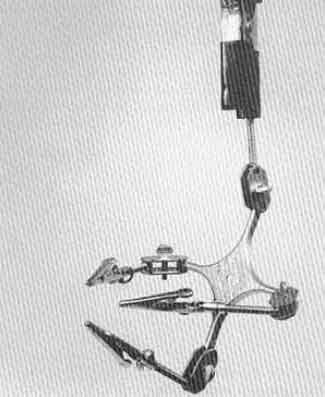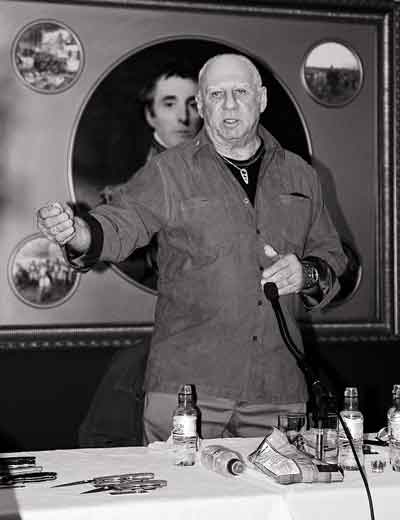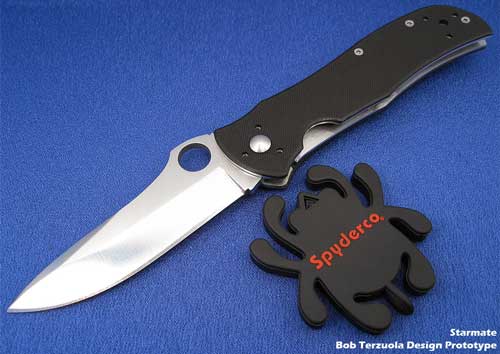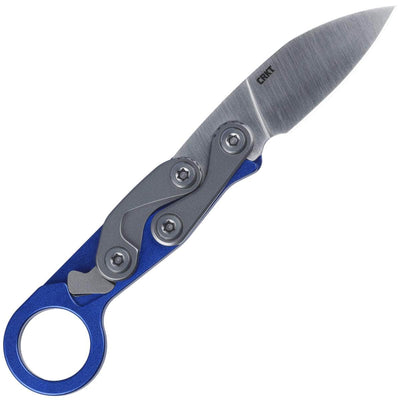Your cart is empty.
All About Spyderco Knives

Quick! List the most respected and innovative knife companies you can think of. If you know anything about knives, Spyderco is somewhere near the top. Spyderco Inc. makes some of the most unique and downright bizarre knife designs you'll see on the market, but from the number of passionate fans discussing, debating, and learning everything they can about Spyderco knives, it's clear that the company has done something right.
But what do you really know about Spyderco? Do you know where the name comes from or what the most iconic model is? We've assembled this ultimate guide that includes everything you ever needed to know about Spyderco and its knives.
Table of Contents
- Chapter 1: The History of Spyderco
- Chapter 2: Important Spyderco Designers/Collaborators
- Chapter 3: Five Most Iconic Spyderco Knives
- Chapter 4: Influential Spyderco Inventions and Philosophies
Chapter 1: The History of Spyderco
Before we go any further, let's go way back to the beginning.
The Origin of the Spyderco Name

The genesis of the company we know today began in 1976 when inventor Sal Glesser created his first product when he wasn't able to find a job. No, it wasn't a knife. It was actually something called the Portable Hand. This strange-looking device allowed people like jewelers and hobbyists to work with small parts because it securely held items in place, leaving both hands free for other purposes. The useful device had a freakish look, which bears a striking resemblance to a spider.
As with any origin story, it's hard to get concrete facts, but according to the Spyderco Story: The New Shape of Sharp by Kenneth T. Delavigne (which is now impossible to find at a reasonable price), it was the spider-like device among other things that helped inspire the name.
Here's an excerpt from the book:
"The name Spyderco and the mascot Spider that became embodied in the company's logo were derived from the word "spyder", which represented two things: the spiderlike shape of the Portable Hand (Sal's first patented invention) and the designation some European automakers gave to high-performance roadsters. High performance, then and now, was what Sal wanted to provide in whatever products he sold."
With that really cool creation, Spyderco was born.
Spyderco's First Knife… C01 Worker

With the success of the Portable Hand, Sal Glesser and his wife, Gail, traveled around to trade shows in a converted bread truck before settling in Golden, Colorado, in 1978. At the same time he went around selling the Portable Hand, he was also inventing the Tri-angle Sharpmaker. The Sharpmaker, which is still in production today, was successful enough to fund some of the research and development on other projects.
Then in 1981, Spyderco released the C01 Worker. The C01 Worker was a knife of many firsts: the first Spyderco knife, the first to feature the trademark round hole for ambidextrous and one-handed opening, the first folder to use the clothing clip. More importantly, the C01 Worker completely shifted the way we interact with knives today.

Giving the People What They Need
It takes time, effort, and patience to become a popular knife brand, but what helped Spyderco succeed was the philosophy of making the best knife possible. While Sal and Gail traveled and sold their knife sharpeners across the country, they would talk with countless people about what they needed in a knife. Like a sponge, the two soaked up the information and took it to heart.
The result of that information was the creation of knives that were not only unique and original but highly functional. With the help of custom knifemaker Al Mar, Sal was able to make contacts in the US that allowed him to manufacture knives at the quality he desired.
The Spydie Logo

Believe it or not, people have both facetiously and seriously asked why Spyderco uses the image of a tick as its logo. While the logo does bear a striking resemblance to the small, parasitic arachnid, it is indeed a spider.
The reason it looks this way is because Sal Glesser was intent on using a spider as the logo, but felt the typical long-legged and pointy spider was too aggressive to put on knives. The solution was this 'cute' spider, in Sal's own words.
Spyderco Today
Since the original C01 Worker, there's been more than 200 models — many successes and some commercial failures. Year after year, Spyderco has released an array of uniquely designed knives that prioritize function over appearance. The end result is an assortment of innovations and knives that changed the knife industry forever. Sal and Gail, along with their son Eric, continue to run the company and now have a team of more than 130 employees.
Read the next sections to see some of the important designers and collaborators.
Chapter 2: Important Spyderco Designers/Collaborators
The list of Spyderco collaborators reads like Who's Who of the knife world. You have names like Ken Onion, Blackie Collins, Wayne Goddard, Bill Moran, and more offering up designs for the innovative company.
While all these knifemakers brought something important to Spyderco, the following designers brought something a little extra.
Sal Glesser
It's impossible to begin this list with anyone other than Sal Glesser. Not only is he the founder and most important person at Spyderco but he's also personally responsible for designing more than a 100 models for the company. No other designer even comes close.
Just a few of his designs include the Ladybug, Delica, Grasshopper, Endura, Resilience, Atlantic Salt, Persistence, Military, Paramilitary, and many more.
Glesser himself holds number of patents that have changed the knife industry, and for all he has brought to the table, Sal was inducted into the Blade Magazine Cutlery Hall of Fame in 2000.
Eric Glesser


The second most important designer at Spyderco shares the same last name as Sal. Eric Glesser is Sal's son and a designer in his own right. He's been working under the tutelage of Sal over the years and has created some of Spyderco's most well-known knives like the Tenacious, Domino (inspired by Kit Carson), Manix 2, and cult favorite Dodo.
He has a fantastic understanding of knife designs and ergonomics. As Sal and his wife Gail continue to get older, Eric has become an increasingly bigger presence in the company, and it's safe to assume the fantastic designs and innovations will continue for a long while.
Ed Schempp


With Ed Schempp, we now venture outside the confines of the company. Schempp is one of Spyderco's most successful and prolific collaborators. His interest in knives began when he used and carried knives at just 5 years old. By the time he was 8, he had a collection of about 20. By the time he was 12, he had made his first knife with a cast fiberglass handle.
His love of knives continued, but his association with Spyderco didn't begin until 2000, when he met Sal Glesser, who eventually ordered one of his custom knives. He made the 25th anniversary Delica model and that progressed into designing some of the ethnic knives for Spyderco.
Some of his Spyderco knives are the Persian, Tuff, Balance, and others.
Bob Terzuola
Spyderco's very first collaboration was with Bob Terzuola way back in 1988. Bob is known as one of the most influential figures in custom knifemaking and an important figure in tactical folding knives.
According to Glesser, Terzuola told him that he made ugly knives, so Glesser said if he could make a pretty one that he'd make it. The result was the C15. This was a knife of many firsts, including the first collaboration, the first liner locking Spyderco, and the first Spyderco produced in the US. Other models he designed are the discontinued but popular Starmate, Slipit and the Double Bevel.
Frank Centofante


The final designer we're highlighting was not only a key person in the development of Spyderco but was also an important person to the knife community. He was a knifemaker for 40 years, president of the American Knifemaker's Guild, author, recipient of the Knifemakers' Guild Red Watson Memorial Friendship Award, and a fireman.
Although he only designed a few knives for Spyderco, Centofante was a key contributor to the manufacturing team, teaching them everything they needed to know about building a quality knife. He passed away in 2009, and Spyderco released the Centofante-designed Memory in his honor.
Another one of his popular Spyderco knives is the Centofante III.
Chapter 3: Five Most Iconic Spyderco Knives
Spyderco has put out some of the most unique knives ever, but only a few truly represent the company as a whole. This means they're the most popular, widely recognized, and game-changing knives Spyderco has ever put out. Let's take a look.
Worker

In terms of important knives that truly embody the spirit and essence of Spyderco, no knife matches up to the first knife the company ever made: the C01 Worker. We take the tactical folding knife for granted nowadays, but back when this came out, it was revolutionary. It was the first knife to offer the Round Hole for one-handed ambidextrous opening and the first to feature a pocket clip.
Although the knife is no longer in regular production, it did come back for a Sprint Run in 2014. The blade is 2.82-inches with a distinctive modified clip point. The original had a stainless steel handle, but the updated version has dark green textured G-10 scales.
It should go without saying that this knife was the catalyst of the company and helped influence many of the knives they (and others) made in the future.
Police

With law enforcement clamoring for a slim, easy-to-carry folder that could hold its own against a fixed blade, Spyderco stepped up to the plate. The result was the formidable Police model. At the time it was released in 1984, it had the longest blade to handle ratio and was an instant hit among police personnel around the world.
After more than 20 years and three generations of the Police, it remains the oldest Spyderco in production, so it's not surprising it's one of the most well-known knives from the company. Each of the three versions stands out on its own, but we'll focus on the original C07 Police.
It has a solid stainless steel handle and long 4.125-inch blade. The blade is also hollow-ground from VG-10 stainless steel and features a classic swedge at the point. This serrated version has the SpyderEdge, but it also comes in a plain and partially serrated edge.
Even though it's been in production for more than 20 years, the Police remains a popular choice among law enforcement and casual users.
Military

The Spyderco Military, fondly referred to as the Millie by fans, is one of the most mimicked knives around. Not only is it one of the most iconic Spyderco knives but it also made our list of most iconic knives ever.
As the cornerstone of the Save and Serve lineup, the Military is a high-performance and lightweight folder that's ready for action. It came about when someone asked Sal Glesser, 'If your son were going into the military what folding knife would you send him with?' After he designed the Military, Glesser could comfortably point to this knife.
The Millie has a 4-inch blade that securely locks with a liner lock into the slender G-10 handle. At the time, it was the first production knife with a blade made of CPM 440V; however, the blade is now made of CPM S30V. The success and popularity of the Military is further demonstrated through the numerous variations designed over the years.
Endura

In 1990, Spyderco shook up the knife world by introducing two new models: the Endura and the Delica. The Endura is the larger of the two knives and won Blade Magazine's Overall Knife of the Year award that year. When the knife was released, it not only exposed Spyderco to the masses but it was also thoroughly mocked for its bizarre look. Needless to say, the knife became highly respected and widely copied.
Now in its fourth iteration, the Endura 4 has a nice 3.75-inch blade made of VG-10 steel with a flat saber grind and larger thumb hole. It has fantastic ergonomics and is considered a fantastic EDC.
Delica

The Delica is the little brother of the Endura and in many ways inseparable from the bigger model. The two are often mentioned together and both have benefitted from Syderco's constant upgrading and updating.
Like the Endura, the Delica 4 is the latest version of the knife and features a smaller 2.875-inch blade with the same VG-10 steel and grind.
The Delica, like the Endura, is an affordable, high-performance folder that's lightweight and boasts easy, one-handed opening. It's hard to see it now that the market is saturated with similar knives, but these two knives truly changed the knife industry and have been the two top sellers at Spyderco for years.
Chapter 4: Influential Spyderco Inventions and Philosophies
Part of Spyderco's philosophy is to inject convenience and innovation into its knives. Many of these innovations have set the standard for other knife brands. Here's a look at the most important things Spyderco has patented or introduced to the knife industry.
Round Hole

The most recognizable and revolutionary feature is the Spyderco Trademark Round Hole. The hole, which was introduced on the C01 Worker in 1981, offers convenient and one-handed access to the blade, regardless of hand size or gloves. Evolving from a dip in the blade, the hole is unique because it allows for ambidextrous opening.
This hole essentially made it mandatory for similar-styled knives to have a method for easy one-handed opening, but most come in the form of a thumb stud. Since the Round Hole is trademarked, you won't see it on other models; however, Benchmade and Ernest Emerson did license the hole for some of their knives.
Clipit Knives

Spyderco didn't create the pocket clip, but it did introduce the clip to the knife world. Before the clip was introduced in 1981, knives were either tucked into the pocket or carried in a sheath. Clipit knives, which Spyderco calls knives with clips, simplified everything.
It made the knife easily accessible in the pocket and safe from loose change. Since the pocket clip was something that could not be patented, others began adopting the pocket clip into their knives. According to Sal Glesser, Lynn Thompson (president of Cold Steel) even paid royalties to Spyderco for using an integral clip, even though he didn't have to.
Since then, the clip has become one of the defining traits of a pocket knife. If that's not a valuable contribution to the world, then I don't know what is.
SpyderEdge

The SpyderEdge is the company's term for its unique serrated design. While Spyderco did not invent the serration, it did set the standard for serrations on pocket knife blades. Claiming the SpyderEdge offers the most efficient cutting performance in a serrated edge, Spyderco is high on serrations and includes them on most models.
The SpyderEdge uses a repeated pattern of one large serration and two small serrations that improve cutting ability. Many companies use their own variations, but some have used or copied the SpyderEdge.
Collaborations with Custom Knifemakers

You'd think something as ubiquitous as collaborations between custom knifemakers and manufacturers is something that's always existed, but it wasn't common before Spyderco. In the second section of this highlight, we wrote about how Bob Terzuola was the first custom collaborator Spyderco ever had, but he was actually one of the first custom collaborators any major company had.
Here's what Spyderco wrote in a feature on Terzuola in 2014:
He also has the distinction of being the first custom knifemaker to collaborate with a major knife company to offer the advantages of his custom designs in a production knife. With his help, Spyderco pioneered the concept of custom knifemaker collaboration and literally changed the face of modern knife manufacturing.
We take it for granted now with countless designs contracted to famous custom knifemakers, but Spyderco spearheaded the movement.
Tactical Folder

A tactical folder is a folding knife designed specifically to be used quickly and effectively in an unknown and potentially threatening situation. What most people don't know is that Spyderco (more specifically Sal Glesser) is the true inventor and pioneer of the tactical folder. Before you get up in arms, let me explain the origins of the tactical folder.
Bob Terzuola, who we wrote about earlier in this article, coined the term 'tactical folder' and is known as the father of the style. The reality is that Spyderco had made tactical folders long before Terzuola coined the term.
Anyone who knows Glesser will tell you he's a humble and open person, but he became riled up after an article in Blade Magazine failed to give Spyderco credit for pioneering the tactical folder. He wrote a strong rebuttal to the article over at Blade Forum about how his good friend Bob Terzuola carried the Spyderco Mariner for five years before making the 'first' tactical folder.
Glesser designed the Worker model based on the criteria of a tactical folder before anyone else had. It could be opened with one hand in a pinch and could be relied upon in dangerous situations.
Here's an excerpt from Glesser's post:
By the time the term "Tactical Folders" was coined by Bob T, Spyderco already had 8 production tactical folders on the market. Spyderco was the first production company to make all black folders as well.
The Endura and Delica which came out in 1990 were certainly tactical folders. With several million out in the field, I would say that they also heavily influenced the tactical folder market. We made and sold more Tactical Enduras in one month than any custom maker will make in their lives.
To put it bluntly, Spyderco is the true father of the tactical folder. That's yet another feather in the cap for the innovative company.























